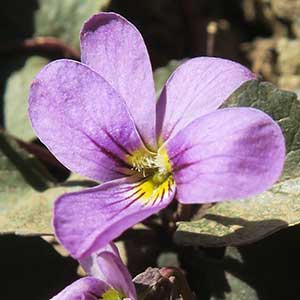Viola flettii
Viola beckwithii
Flett's violet, Olympic violet, rock violet
Beckwith's or Great Basin violet, Beckwith's violet, Great Basin violet, sagebrush pansy, sagebrush violet
1–3, ascending to erect, mostly glabrous, on caudex from fleshy rhizome.
1–3, decumbent, ascending, or erect, ca. 1/2 subterranean, glabrous or usually puberulent, on single, short, vertical, deep-seated caudex.
basal and cauline;
basal: 1–3;
stipules linear-lanceolate, margins entire or with glandular processes, apex acuminate;
petiole 1.5–9.7 cm, mostly glabrous;
blade purple-tinted and –veined, broadly reniform to ovate, 0.9–2.4 × 1.2–4 cm, base cordate, margins finely crenate-serrate, eciliate, apex acute to obtuse, surfaces glabrous or sparsely pubescent along veins adaxially;
cauline similar to basal except: stipules ovate to lanceolate, margins entire or shallowly laciniate;
petiole 0.7–5.9 cm, usually glabrous;
blade 0.8–2.1 × 1.2–3.1 cm.
basal and cauline;
basal: 1–6 per caudex, palmately compound, ± 2-ternate or 3-ternate, leaflets 3;
stipules adnate to petiole, forming 2 linear-lanceolate wings, unlobed, margins entire, apex of each wing free, acute;
petiole 2–10.5 cm, usually puberulent;
blade ovate to deltate, 2.4–5 × 3.5–4.5 cm, base tapered, ultimate leaflets dissected into oblong, elliptic, lanceolate, or oblanceolate lobes 1–7 mm wide, lobe margins entire, usually ciliate, apex acute to obtuse, mucronulate, surfaces usually puberulent, seldom glabrous, abaxial surface without prominent vein parallel to each margin;
cauline similar to basal except: stipules linear, apex acuminate;
petiole 2–5.7 cm, usually puberulent, rarely glabrous;
blade 1–2.7 × 1.5–3 cm.
1.8–7.1 cm, usually glabrous.
1.5–10.6(–15.7) cm, usually puberulent, seldom glabrous.
sepals lanceolate, margins eciliate, auricles 0.5–1.5 mm;
petals soft reddish violet on both surfaces, all with yellow area basally, lower 3 dark violet-veined, lateral 2 bearded, lowest with white around yellow area, 10–15 mm, spur yellow, gibbous, 0.5–2 mm;
style head bearded; cleistogamous flowers axillary.
sepals lanceolate, margins eciliate, auricles 0.1–1 mm;
petals dark reddish violet on both surfaces, lower 3 usually lilac, rarely white or whitish, lateral 2 bearded, with yellow patch basally, dark reddish violet-veined, lowest 10–22 mm, with yellow patch, dark reddish violet-veined, spur whitish or yellowish, tinged purple, gibbous, 0.5–2 mm;
style head bearded; cleistogamous flowers absent.
± spherical, 5–9 mm, glabrous.
oblong-ovoid, 7–12 mm, glabrous.
dark brown to brownish purple, 2.5–3 mm.
brown, 3–4 mm.
= 24.
Viola flettii
Viola beckwithii
Viola flettii is endemic to the Olympic Mountains of northwestern Washington. C. S. McCreary (2005) noted that although morphologically and ecologically distinct, V. cuneata, V. flettii, and V. ocellata are closely related.
(Discussion copyrighted by Flora of North America; reprinted with permission.)
In some populations of Viola beckwithii, the three lower petals are white with a yellow area proximally (V. B. Baird 1942). Leaves have been described as palmately biternate or triternate (L. Abrams and R. S. Ferris 1923–1960, vol. 3), ternately decompound into linear segments (C. L. Hitchcock et al. 1955–1969, vol. 3), palmately three-parted then bipinnately parted into ultimate linear or spatulate segments (P. A. Munz 1959), and palmately about three times three-parted into linear or spatulate-linear segments (W. L. Jepson 1951). Some populations in northern California are nearly or completely glabrous, which M. S. Baker recognized as var. glabrata.
Viola beckwithii is reported to hybridize with V. utahensis (G. Davidse 1976). Observed pollinators of V. beckwithii in Utah include Apis mellifera Linnaeus and Anthophora ursina Cresson (Davidse).
When Cottam described Viola bonnevillensis, he suggested that it could be a hybrid between V. beckwithii and V. utahensis, and G. Davidse (1976) concurred. The type specimen of V. bonnevillensis (Cottam 7067, UT) was examined by R. J. Little. Because no similar forms are known to have been collected since 1939, it is presumed that this taxon is a hybrid.
(Discussion copyrighted by Flora of North America; reprinted with permission.)


